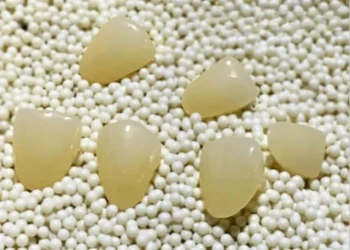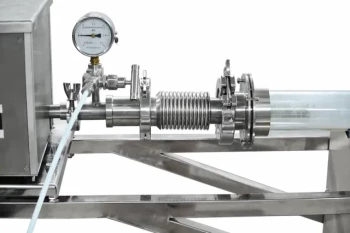Articles

Cold Isostatic Pressing A Game Changer in Material Science
2 years agoCold Isostatic Pressing (CIP) is a powder compaction process used to produce parts with uniform density and minimal porosity. The process uses a fluid medium, typically water, to apply equal pressure to a powder-filled container from all sides.
Learn More

How Rotary Evaporators Help in Separation Processes
2 years agoRotary evaporators, or rotovaps, are laboratory equipment used in separation processes to remove solvents from samples.
Learn More

CIP vs. Metal Mold Pressing What's the Difference
2 years agoCIP and Metal Mold Pressing are used to create high-density components, but they differ in terms of the level of complexity required and the final outcome. Understanding these differences can help manufacturers determine which method is best suited for their needs.
Learn More

How Rotary Evaporator Can Improve the Quality of Your Distillate
2 years agoA rotary evaporator is a laboratory equipment used for distillation and solvent recovery processes. It works by rotating the flask containing the mixture under vacuum, which allows for efficient separation of the components based on their boiling points.
Learn More

Key Factors to Consider When Using Warm Isostatic Press
2 years agoWarm Isostatic Press is a type of high-pressure processing that uses heat and pressure to densify materials. It is a popular method of producing high-quality, near-net-shape components from ceramics, metals, and other materials.
Learn More

CIP Revolutionizing the Manufacturing Industry
2 years agoCold Isostatic Pressing (CIP) is a manufacturing process that involves applying high pressure to a sample in a liquid medium to create a uniform and dense material.
Learn More

5 Essential Applications of Rotary Evaporator in Labs
2 years agoRotary evaporators, also known as rotovaps, are laboratory instruments used for distillation, concentration, and purification of samples. They are widely used in the chemical, pharmaceutical, and food and beverage industries for various applications.
Learn More

Benefits of Cold Isostatic Pressing (CIP)
2 years agoCold Isostatic Pressing (CIP) is a powder compaction method that uses a fluid medium, such as water or oil, to apply uniform pressure to a powder sample.
Learn More

How to Ensure Workplace Safety When Using a Hydraulic Press in Your Lab
2 years agoHydraulic presses are essential tools in many laboratories, used for a range of applications such as sample preparation for chemical analysis, material testing, and pressing powders.
Learn More

Simplify Sample Preparation with FTIR Pellet Press
2 years agoFTIR (Fourier Transform Infrared) spectroscopy is a powerful analytical technique used to identify and quantify the chemical composition of materials.
Learn More

Achieving Optimal Density with Isostatic Pressing
2 years agoIsostatic pressing is a manufacturing process that uses fluid pressure to compress and shape materials into various forms.
Learn More

Pseudo-Reference Electrodes When and How to Use Them
2 years agoReference electrodes are an essential component in electrochemical measurements. They are used to establish a stable and reproducible potential for the working electrode and provide a reference point for the measurement. The reference electrode should have a stable and well-defined potential, which is independent of the solution's composition and the working electrode's potential.
Learn More

AgAgCl Reference Electrode Working Principle and Applications
2 years agoAg/AgCl reference electrode is a widely used reference electrode due to its stable potential and long-term stability.
Learn More

Dental Ceramic Furnaces The Science Behind It
2 years agoDental ceramic furnaces play a crucial role in the production of dental restorations such as crowns, bridges, and veneers.
Learn More

How to Make Your Own Ag/AgCl Reference Electrode for Electrochemical Experiments
2 years agoA reference electrode is an electrode with a stable and well-defined potential that is used as a reference point to measure the potential of other electrodes. Reference electrodes are commonly used in electrochemical experiments to determine the potential difference between two electrodes.
Learn More

A Guide to Choosing the Right Reference Electrode for Your ISE Analysis
2 years agoReference electrodes are an essential component of any electrochemical measurement.
Learn More

Dental Furnaces The Perfect Solution for Porcelain Processing
2 years agoThe dental furnaces are designed explicitly for the firing process of dental porcelain, which is a crucial step in the dental restoration process.
Learn More

A Comprehensive Guide to Reference Electrodes
2 years agoReference electrodes are used in electrochemical measurements to establish a stable potential against which the potential of the working electrode can be measured.
Learn More

Electrolytic Batteries A Solution to the Growing Energy Demands
2 years agoThe design of electrolytes remains a challenge, but automated discovery and the power of AI are promising tools for advancing this field.
Learn More

How to Choose the Right Reference Electrode for Your Application
2 years agoWhen it comes to measuring the electrical potential of a solution accurately, a reference electrode is an essential tool in the laboratory. It provides a stable and consistent reference point for other electrodes to measure against, ensuring accurate and reliable results.
Learn More

How to Maintain Your Dental Ceramic Furnace
2 years agoThe dental furnaces are expensive and require regular maintenance to ensure they function properly and produce accurate results.
Learn More

CVD furnace for the growth of carbon nanotubes
2 years agoChemical vapor deposition (CVD) furnace technology is a widely used method for growing carbon nanotubes.
Learn More

The Role of Plasma in PECVD Coatings
2 years agoPECVD (Plasma Enhanced Chemical Vapor Deposition) is a type of thin film deposition process that is widely used for creating coatings on various substrates. In this process, a plasma is used to deposit thin films of various materials onto a substrate.
Learn More

A Guide to Choosing the Right Temperature for Warm Isostatic Press
2 years agoWarm Isostatic Pressing (WIP) is a process used to eliminate porosity and improve the mechanical properties of materials. In this process, the material is subjected to high pressure and temperature in an inert gas environment.
Learn More

The Latest Advancements in Zirconia Sintering Furnaces for Dental Applications
2 years agoZirconia sintering furnaces are designed to give dental professionals the ability to create dental restorations with the highest level of precision and accuracy.
Learn More

Understanding the PECVD Method
2 years agoPECVD is a plasma-enhanced chemical vapor deposition process that is widely used in the production of thin films for various applications.
Learn More

Electrode Materials for Rotating Ring-Disk Electrodes
2 years agoRotating ring-disk electrodes (RRDEs) are used in a wide range of applications, from fuel cells to sensors, and they require careful selection of electrode materials for optimal performance.
Learn More

Understanding the Function of a Dental Ceramic Furnace
2 years agoDental ceramic furnaces are specialized equipment used in the dental laboratory to create high-quality dental restorations, such as crowns, bridges, and veneers.
Learn More

The fascinating technology (HPHT & CVD) of the diamond growing machine
2 years agoThey are created using either the High Pressure High Temperature (HPHT) process or the Chemical Vapor Deposition (CVD) technique, both of which mimic the natural conditions under which diamonds are formed.
Learn More

Key Materials for Successful CVD Processes
2 years agoThe success of CVD processes is dependent on the availability and quality of precursors used during the process.
Learn More